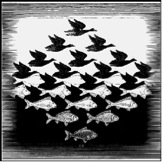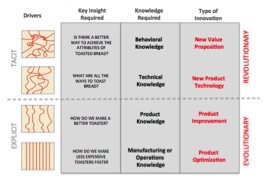M.C. Escher Sky and Water I, 1938
Last week I gave a talk to a group of graduate students who are in a hands-on course to find innovative solutions to problems posed by real clients. As the first industry lecture of the semester, I was to talk about the very front-end of the innovative problem solving process.
As most of these students were from either the medical or engineering schools, they were very bright, and naturally very good at problem solving. As a result, most of their initial questions were about how to find unique sources of information, how to elicit insightful answers from customers, and how to ensure that they would find solutions that were not yet patent protected. These were all very logical, straightforward questions that directly attacked the problems assigned by their clients.
Of course, my response went against everything they had learned about problem solving thus far. I told them that the best approach was not to try to solve the stated problem directly, but to explore the nuances as to why the stated problem was posed in the first place.
Here’s what I meant by my response. All of their clients have deep expertise in the specific operational aspects of their businesses, and many have deep knowledge of the current preferences of the people in their target markets. That someone with no knowledge would uncover a potential breakthrough that has been missed in the clients area of expertise is not very likely. On the other hand, such deep expertise often results in problems that are too narrowly focused, and the opportunity to pose problems that would lead to truly unique solutions can be missed.
Heres an example of how that could work. I was at lunch with a friend the other day who is a vegetarian. She loves tofu, but sometimes gets tired of it. One way to approach this problem is to find new ways to serve tofu so that she could have the variety she was looking for. However, another way is to find out why she loves tofu, and why she gets tired of it. If we were to find out that what she loved a bout tofu is that it is a low fat alternative protein source. At that point, the problem changes from what are all the ways to prepare tofu to what are all the low fat alternative protein sources. Now imagine the variety we could provide for her!, we could then pose a completely different problem. Instead of searching for all the ways to serve tofu, we could search for all sources of protein alternatives that are low in fat. Now imagine the variety we could provide for her!
This shift is not the result of a radically new approach to research, but is the result of taking the time to understand the nuance behind what she was saying. As described in my recent post about the different dimensions of innovation, this shift in perspective elevates our thinking from how do we improve our current products to how can we find new sources of value to offer our customers, as illustrated below:
Its easy to take the given data at face value and the face value is readily available to everyone, competitors and collaborators alike. If we have the discipline to examine the nuances of why the data is what it is, then we can go in directions our competitors may never think of, and thats where we can create our unique value. Its like the Escher drawing at the beginning of this post. Think of the middle as the basic data that everyone has access to. Its easy to see that expressing subtle nuances can lead to vastly different conclusions.
I told the students that this is where they can then apply their analytical training. Rather than trying to find new solutions to stated problems, they can find the nuances behind data, and then apply their analytical training to best express those nuances. Its from this critical understanding that the students can create unique sources of competitive advantage, based on the original problems posed by their clients.


